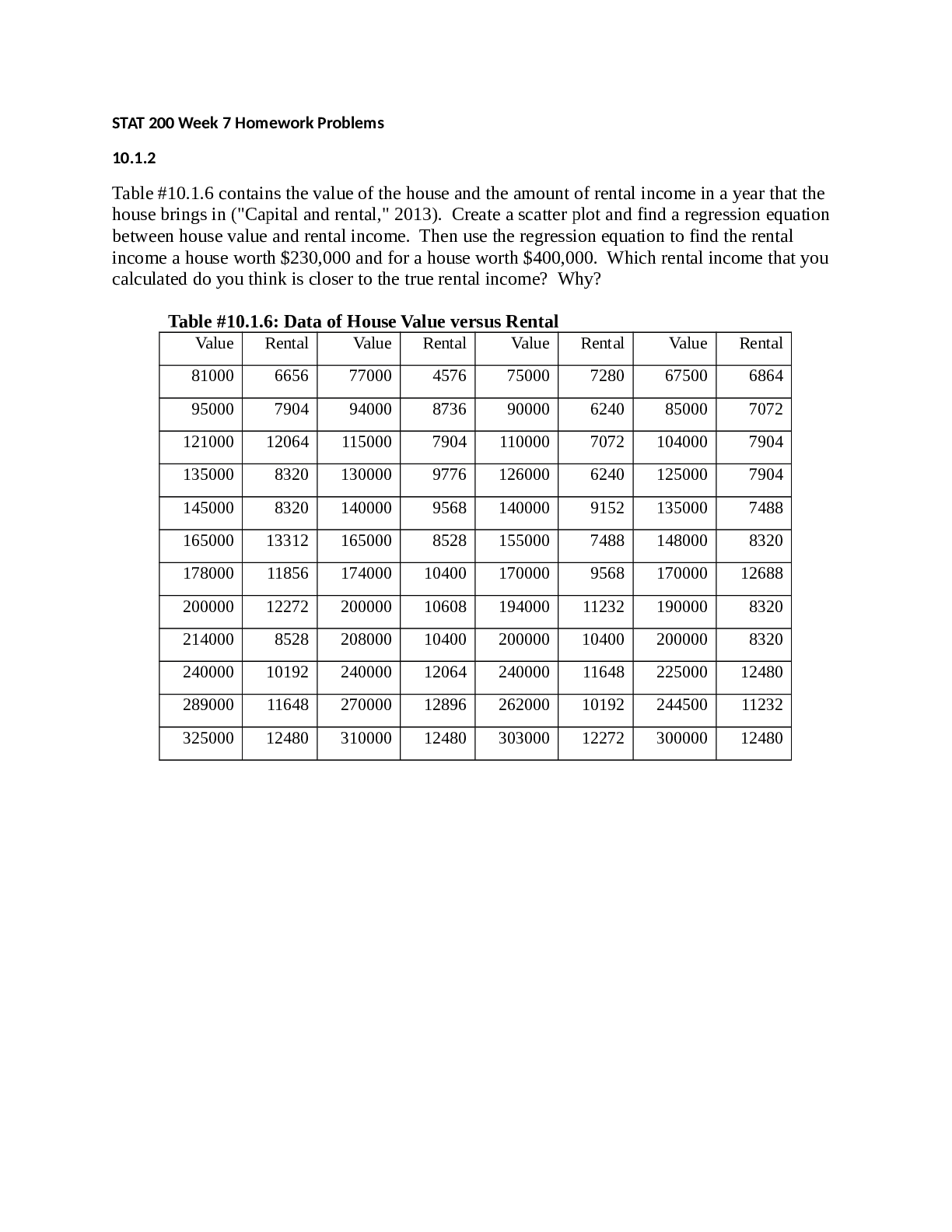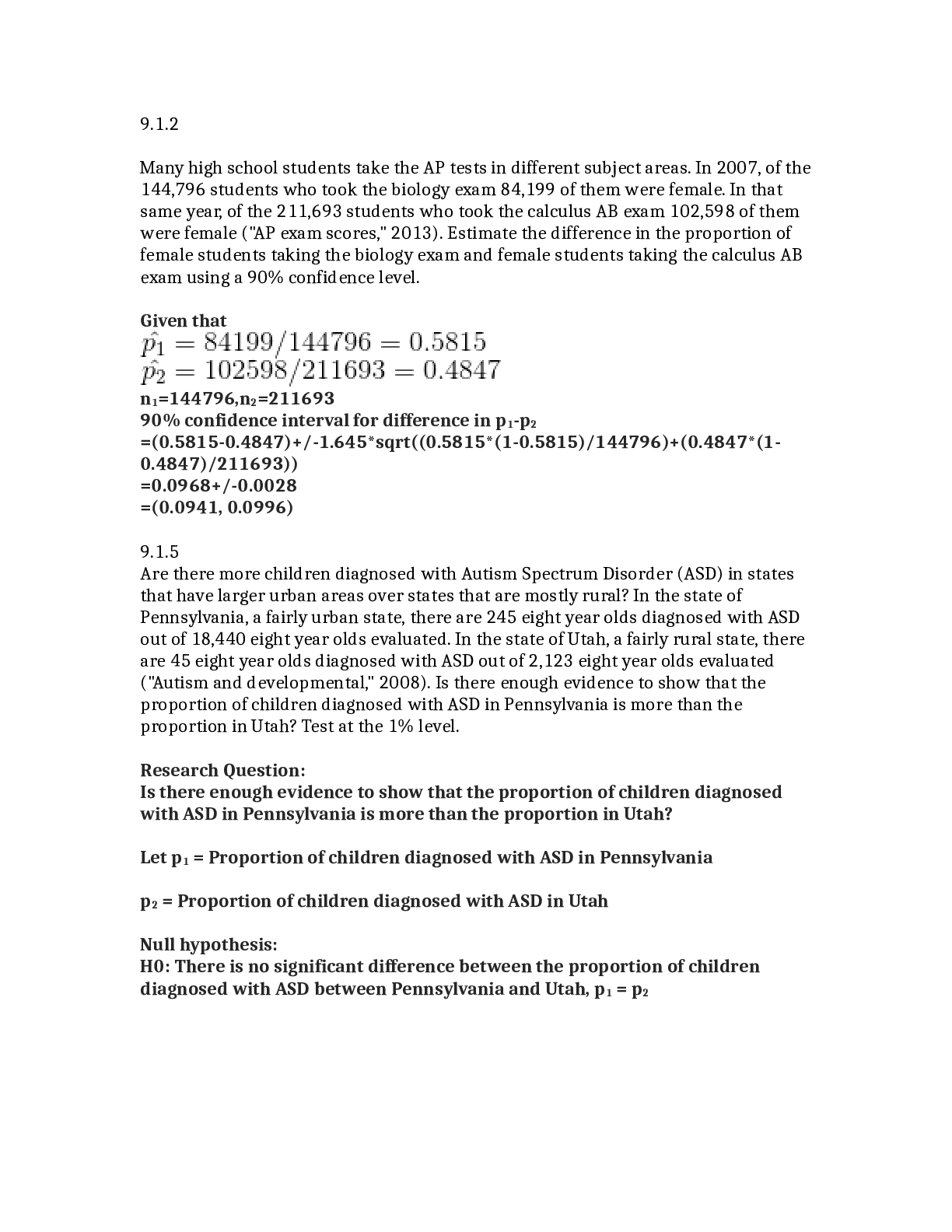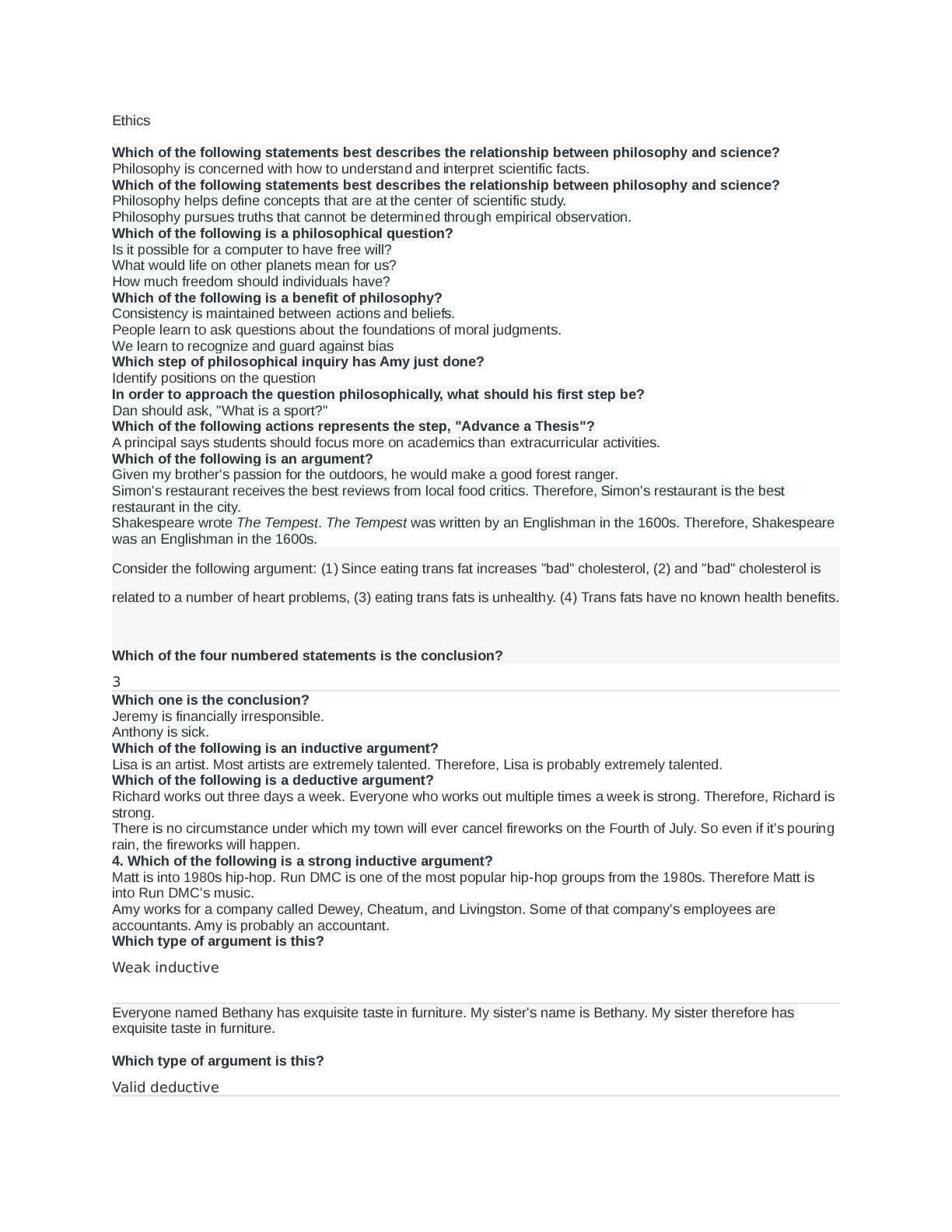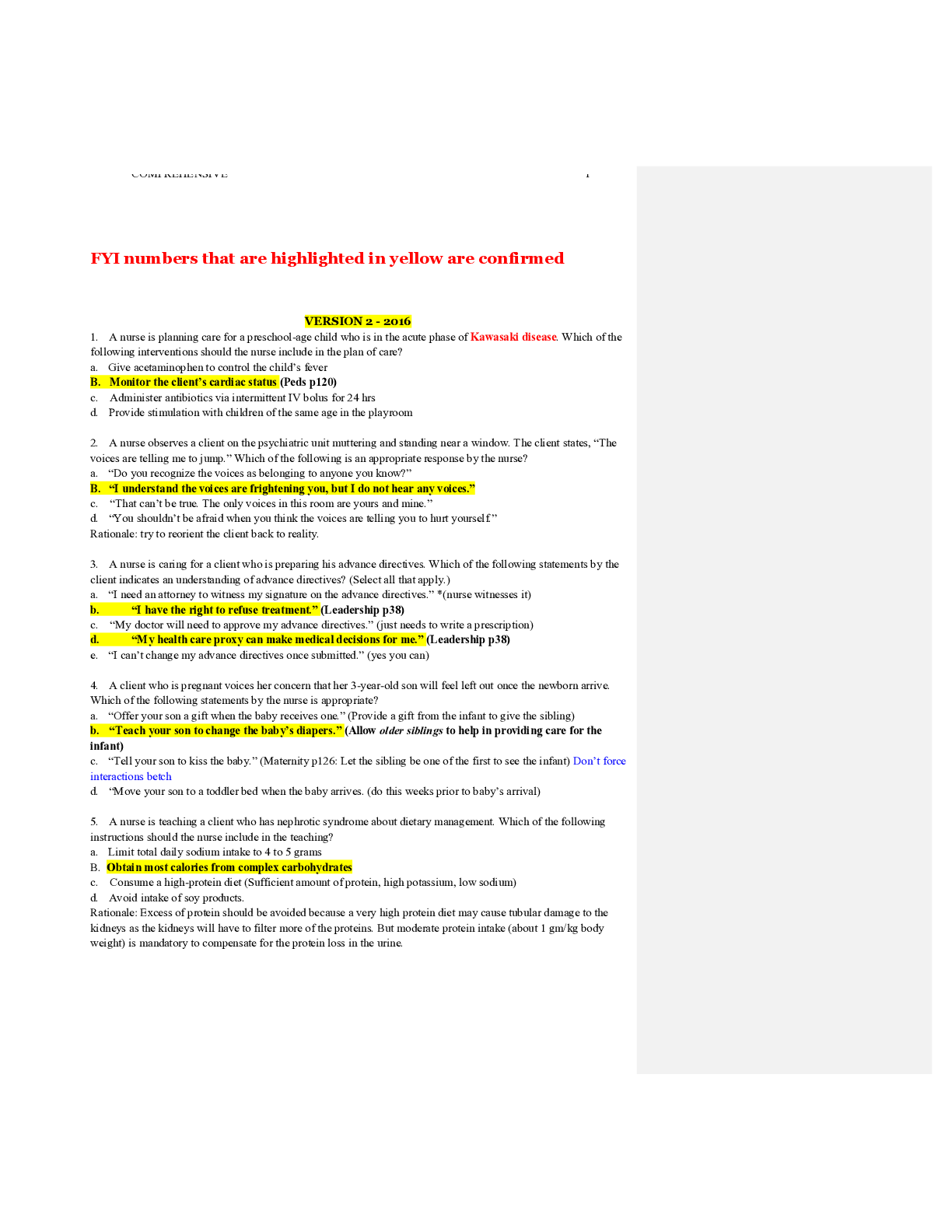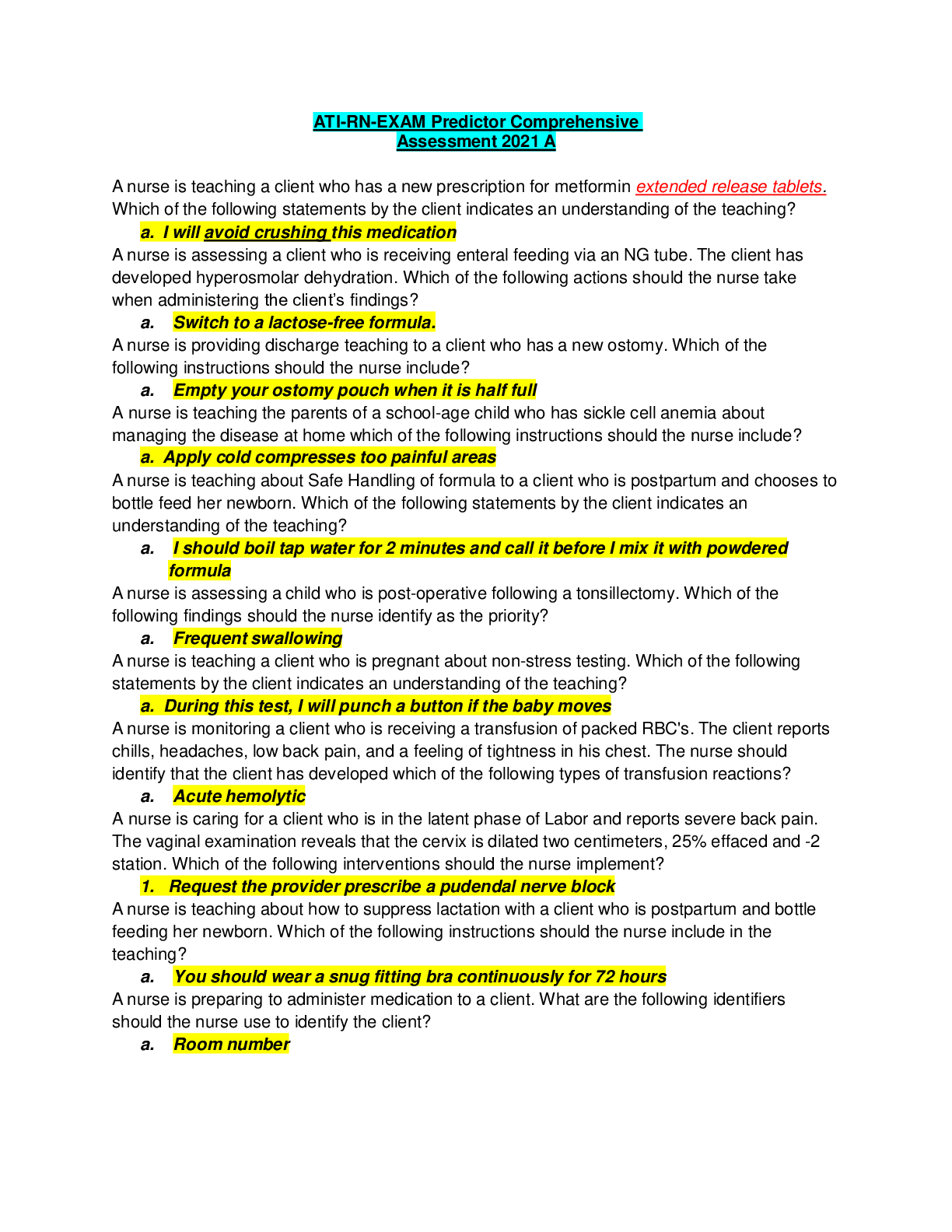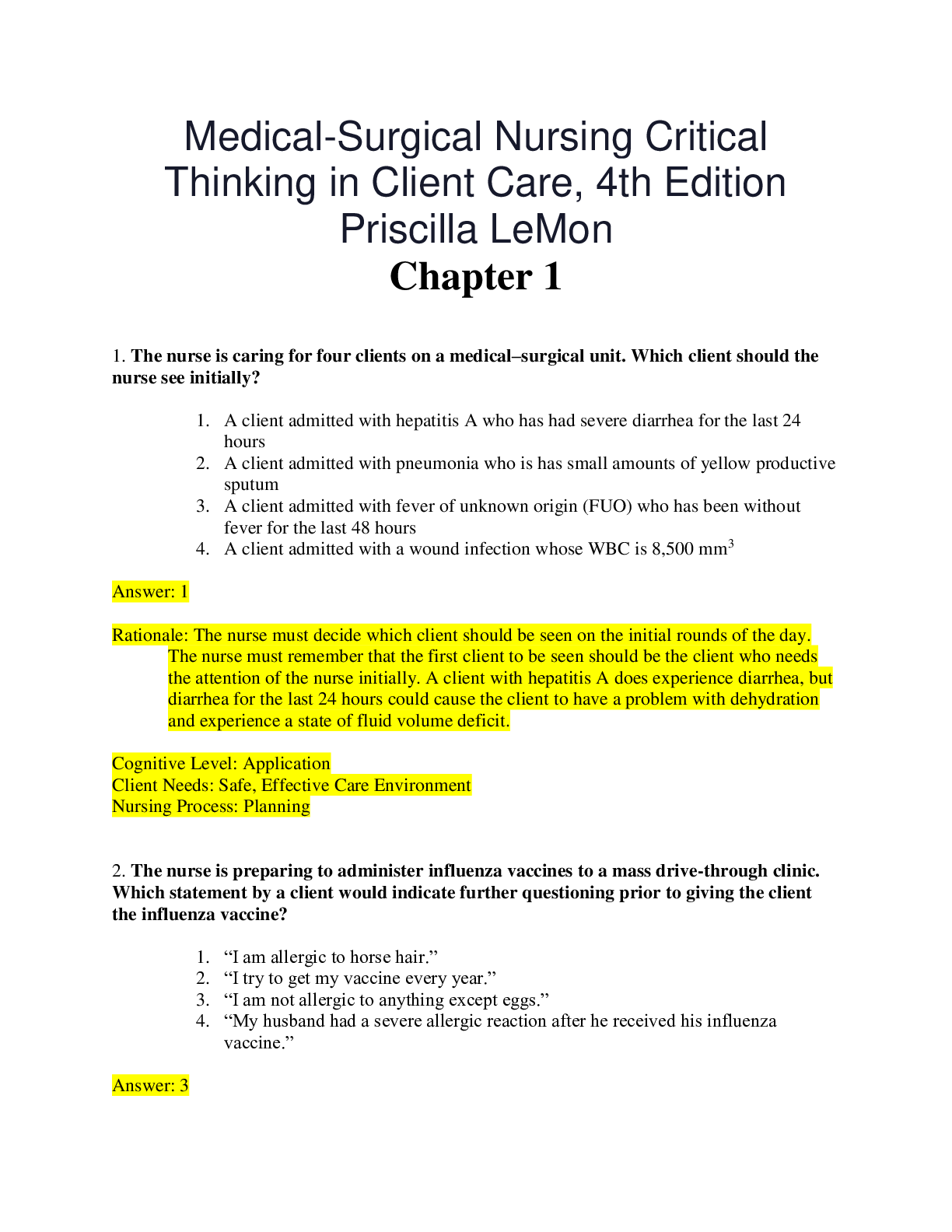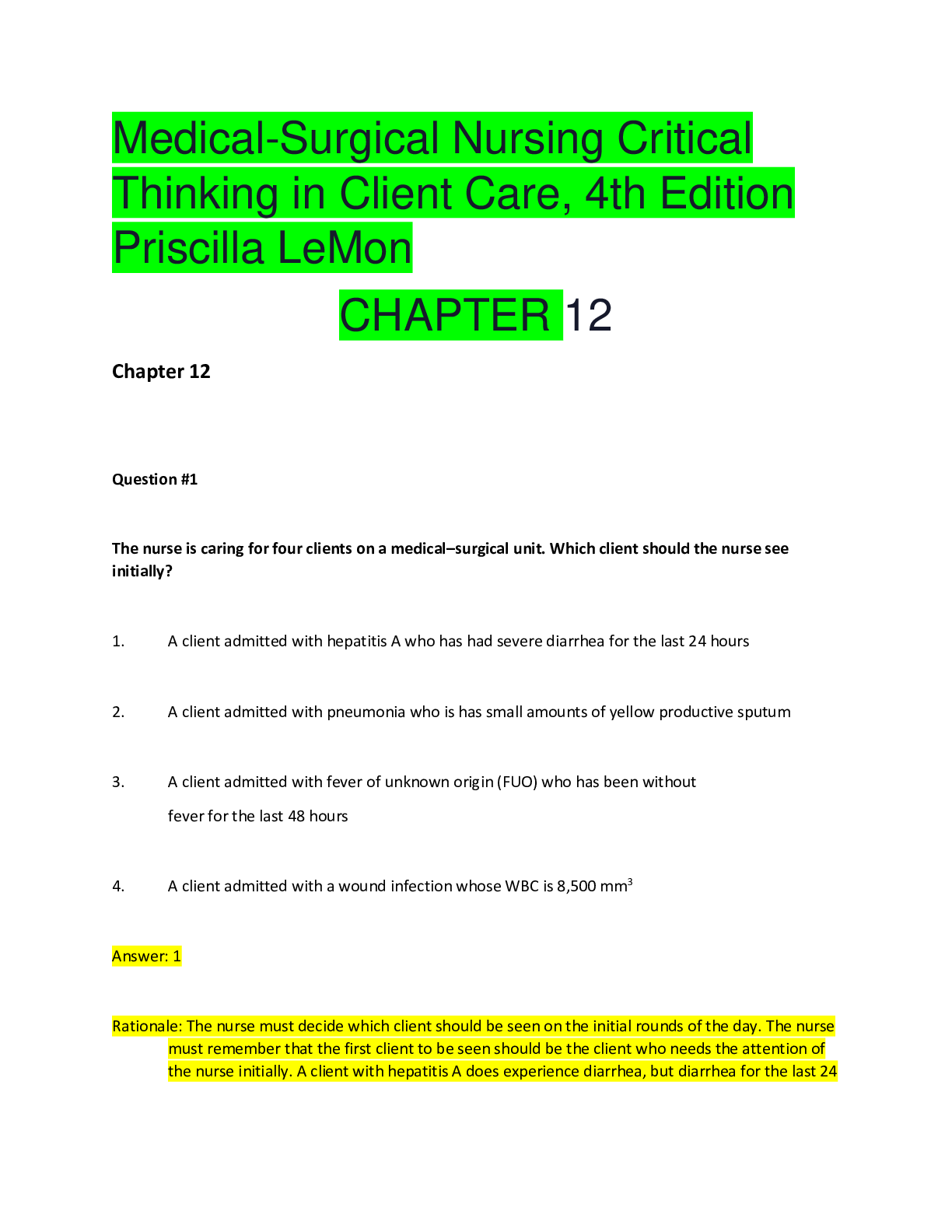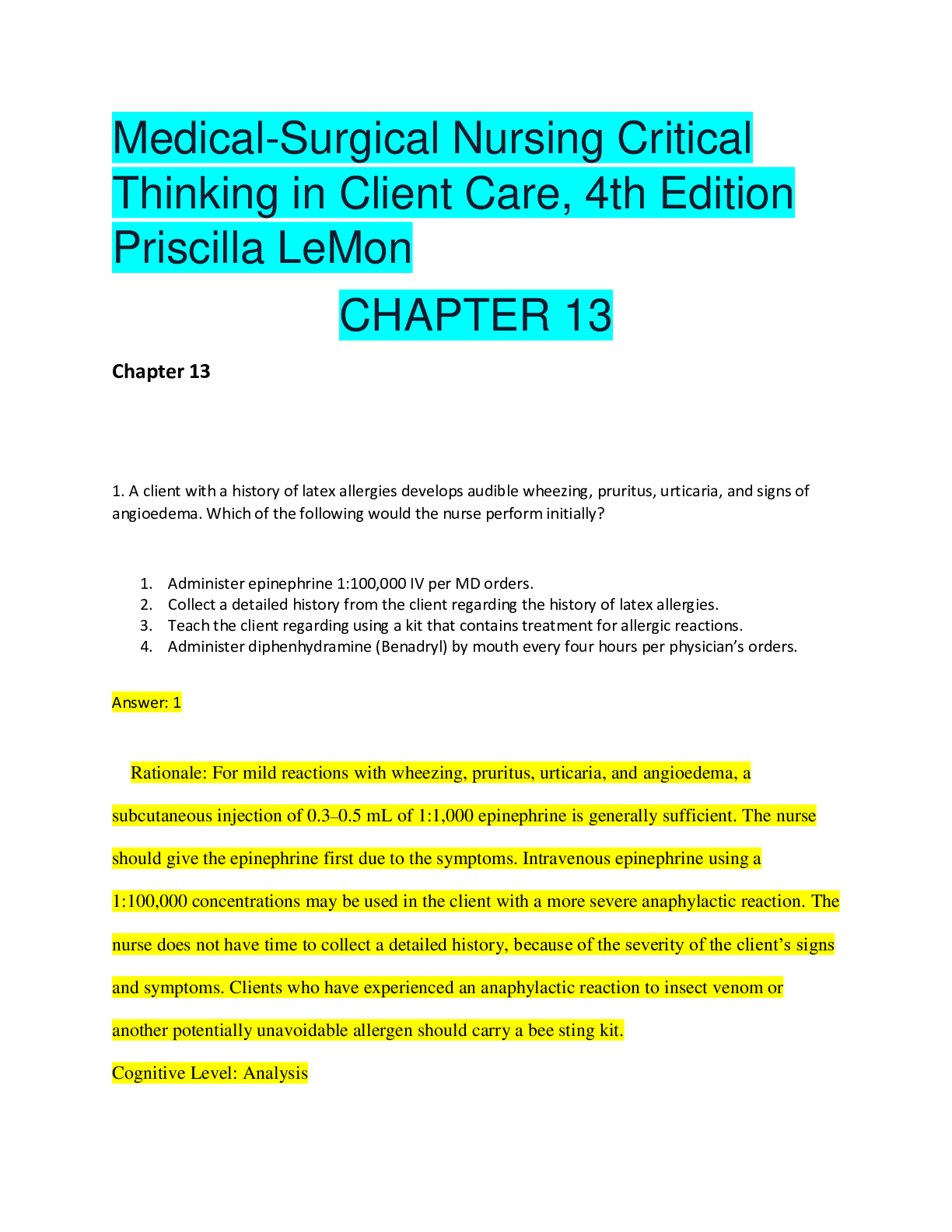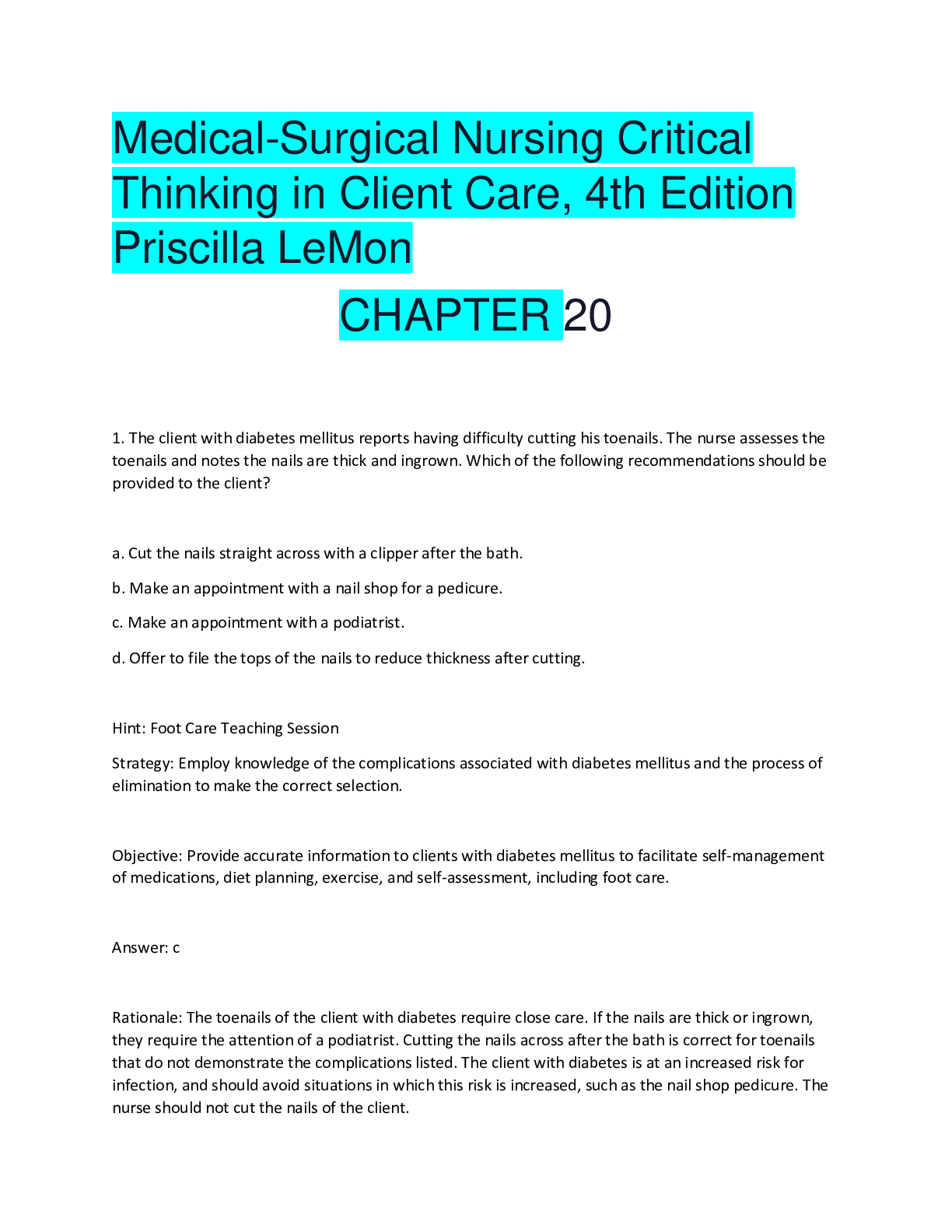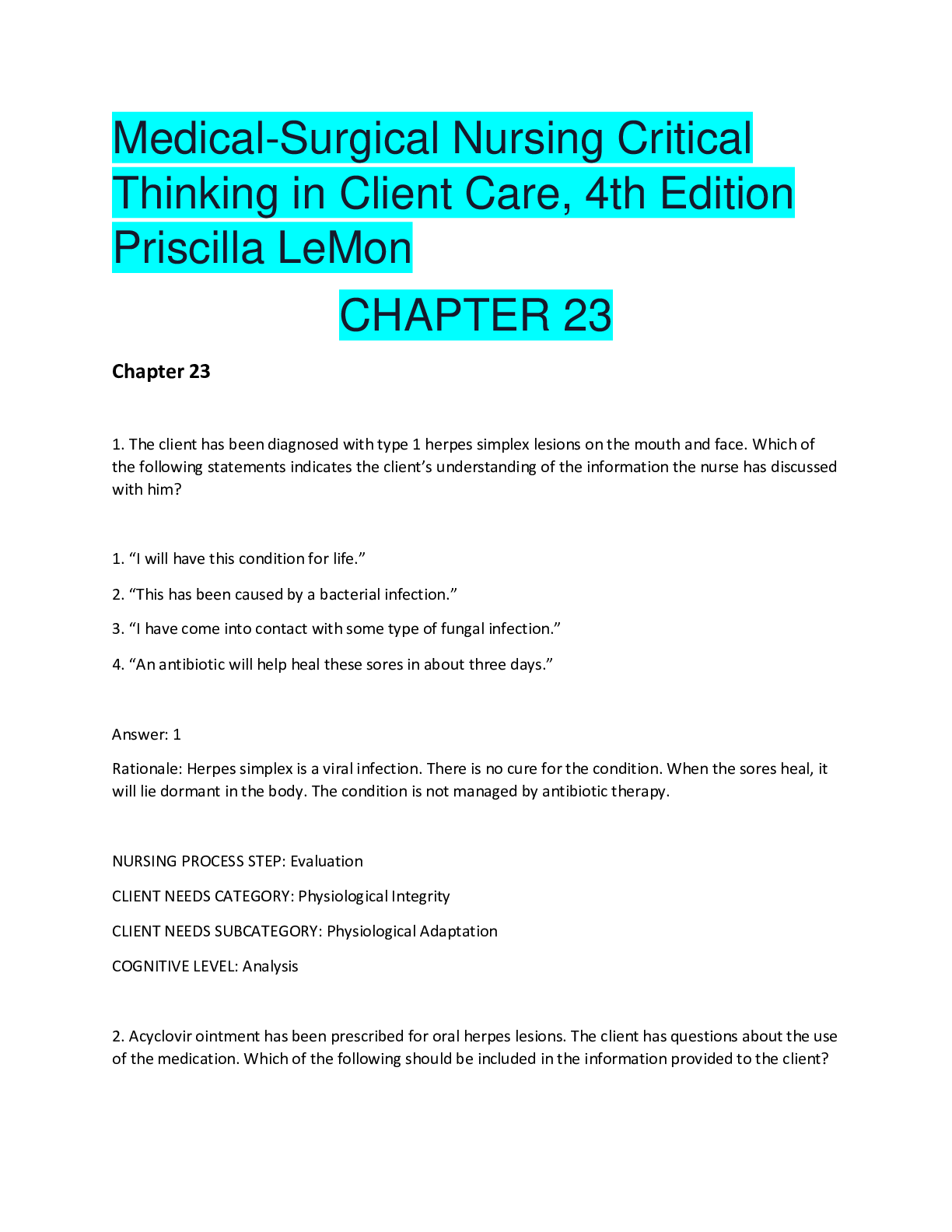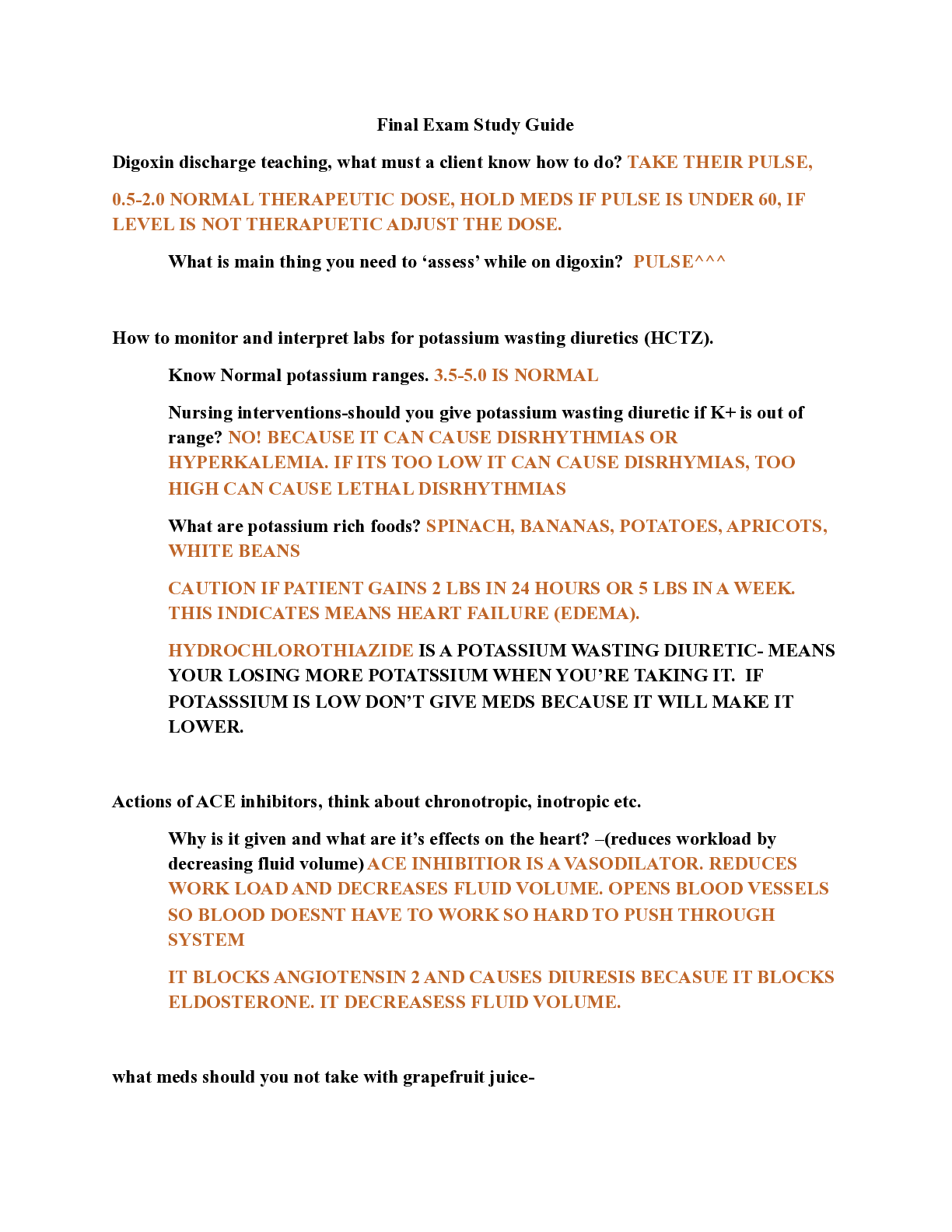*NURSING > QUESTIONS & ANSWERS > AGNP BOARD EXAM QUESTIONS Endocrinology Prescription_2021_89 Questions With Correct Answers And Rati (All)
AGNP BOARD EXAM QUESTIONS Endocrinology Prescription_2021_89 Questions With Correct Answers And Rationale
Document Content and Description Below
AGNP BOARD EXAM QUESTIONS Prescription of Endocrinology (89 Questions) Question: When patients administer regular insulin (Humulin R U-500), they should be taught: 5 units of Humulin R U-500 is equ... al to 10 units on a U-100 insulin syringe. 10 units of Humulin R U-500 is equal to 5 units on a U-100 insulin syringe. 10 units of Humulin R U-500 is equal to 10 units on a U-500 insulin syringe. Correct it should only be used in an insulin pump. Explanation: U-500 insulin is a concentrated form of insulin containing 500 units of insulin per mL. U-500 regular insulin vials are to be used only in conjunction with a dedicated U-500 insulin syringe; dosage conversion is not required with the U-500 syringe. When using a U-100 syringe or a tuberculin syringe to deliver Humulin R U-500 (from vial), a conversion step is required to ensure the correct amount of Humulin R U-500 is drawn up in the syringe. To avoid dosing errors when using a U-100 insulin syringe, the prescribed dose should be written in actual insulin units and as unit markings on the U-100 insulin syringe (e.g., Humulin R U-500 50 units = 10 units on a U-100 insulin syringe). For safety, ONLY the U-500 syringe should be used. It is not recommended for use in insulin pumps due to possibility of precipitation. Question: Patients taking thiazolidinedione (TZD) medications should be monitored for: diarrhea and flatulence. fluid retention and weight gain. Correct hypotension and dizziness. weight loss and fatigue. Explanation: Thiazolidinediones including pioglitazone hydrochloride (Actos), may precipitate or exacerbate heart failure in some patients by causing dose-related fluid retention. After initiation of pioglitazone tablets, and after dose increases, monitor patients carefully for signs and symptoms of heart failure (e.g., excessive, rapid weight gain, dyspnea, and/or edema). If heart failure develops, pioglitazone should be discontinued or dosage reduced. Pioglitazone tablets are not recommended in patients with symptomatic heart failure. Initiation of pioglitazone hydrochloridein patients with established New York Heart Association (NYHA) Class III or IV heart failure is contraindicated. Question: A patient diagnosed with Type 2 diabetes mellitus has an initial hemoglobin A1C of 7.2%. Assuming no contraindications, the American Diabetes Association's (ADA) initial recommendation for this patient includes: acarbose (Precose). metformin (Glucophage). Correct glipizide (Glucotrol). liraglutide (Victoza). Explanation: Metformin (Glucophage) is the initial recommended pharmacological treatment for type 2 diabetes mellitus, providing there are no contraindications. The other medications have FDA indications as monotherapy for treatment in this patient, but are not as evidence-based as metformin, and thus not initially recommended by ADA. Question: Gynecomastia is NOT likely to be caused by: clonazepam. Correct ketoconazole. lavender oil. marijuana. Explanation: Gynecomastia is not likely to be caused by clonazepam (Klonopin). Ketoconazole, finasteride, spironolactone, lavender oil and tea tree oil are identified as androgens or inhibitors of androgen synthesis and thus are associated with gynecomastia. Alcohol, amphetamines, heroin, marijuana and methadone are also potential medication-related causes of gynecomastia. Question: Which of the following medications may cause gynecomastia? amlodipine (Norvasc). enalapril (Vasotec). Correctlosartan (Cozaar). verapamil (Calan). Explanation: Enalapril (Vasotec) and captopril (Capoten) are angiotensin-converting enzyme inhibitors used in the treatment of hypertension. They may cause gynecomastia. Question: Sodium-glucose co-transporter 2 (SGLT2) inhibitors reduce blood glucose by: increasing insulin sensitivity at the cellular level. increasing urinary glucose excretion. Correct potentiating insulin secretion from the pancreas. suppressing glucagon secretion from the liver. Explanation: Sodium-glucose co-transporter 2 (SGLT2) are transporters of glucose in the kidney's proximal tubules and mediate reabsorption of approximately 90% of the filtered renal glucose load. Sodium-glucose co-transporter 2 (SGLT2) INHIBITORS inhibit this action. Examples include dapagliflozin (Farxiga), canagliflozin (Invokana), and empagliflozin (Jardiance). These SGLT2 inhibitors decrease renal uptake of glucose and promote renal excretion of glucose by lowering the renal threshold for glucose. Thus, more glucose is excreted. This modestly lowers elevated blood glucose levels in patients with type 2 diabetes. Question: A patient who is started on a glucagon-like peptide (GLP-1), such as Victoza, should be informed that this class of medications may: increase satiety. Correct cause hypoglycemia. cause weight gain. are inexpensive. Explanation: Advantages of glucagon-like peptide (GLP-1) incretin mimetics such as Byetta, Victoza, Trulicity, and others include that they delay gastric emptying, increase satiety and promote weight loss. The disadvantages are that they must be injected, are expensive, and the long-term effects are not known.Question: The most frequent side effect of metformin (Glucophage) is: diarrhea. Correct hypoglycemia. heartburn. constipation. Explanation: The most frequent side effect of metformin (Glucophage) is gastrointestinal upset; including diarrhea, nausea and flatulence. These symptoms are usually dose dependent and may be alleviated by decreasing the dose, prescribing a once-daily formulation, or administering the medication at nighttime. Question: Patients taking dipeptidyl-peptidase-4 (DDP-IV) inhibitors for the treatment of Type 2 diabetes do NOT routinely need to be monitored for: pancreatitis. severe joint pain. skin exfoliation. weight loss. Correct Explanation: Dipeptidyl-peptidase-4 (DDP-IV) inhibitors including sitagliptin (Januvia); saxagliptin (Onglyza) and linagliptin (Tradjenta) are used in the treatment of Type 2 diabetes. They are NOT likely to cause weight loss or weight gain or risk of hypoglycemia (in the absence of concomitant treatment with insulin or sulfonylureas). Anaphylaxis, angioedema, and exfoliative skin conditions including Stevens-Johnson syndrome, severe and disabling arthralgia and acute pancreatitis (sometimes fatal) syndrome have been reported. Question: A patient who has Addison's disease has received a prescription for fludrocortisone. Fludrocortisone acts by: suppressing immunity. increasing inflammation.regulating salt and water balance. Correct preventing the breakdown of glucose. Explanation: Fludrocortisone is a mineralocorticoid. It is indicated as partial replacement therapy for patients who have primary or secondary adrenocortical insufficiency in Addison's disease. Question: A 63-year-old woman with Type 2 diabetes mellitus has been treated with metformin (Glucophage) for the past 3 months. Baseline estimated glomerular filtration rate was 63. Renal function on this patient should be checked: every 6 months regardless of baseline estimated glomerular filtration rate. every 6 months when estimated glomerular filtration rate is >60. at least annually when estimated glomerular filtration rate is 60 or greater. Correct every 3 months when estimated glomerular filtration rate is less than 80. Explanation: Renal function studies for patients receiving metformin (Glucophage) should be performed annually when eGFR is 60 or greater; every 3-6 months for eGFR between 45-59; and every 3 months for eGFR between 30-44. Metformin (Glucophage) should not be initiated on a patient with a baseline eGFR between 30-44, but should be monitored closely if renal function decreases and falls within that range. It should be discontinued when eGFR falls below 30. Question: Because of the mechanism of action, patients should be instructed to administer exenatide (Byetta): daily at bedtime. immediately following the largest meal of the day. twice daily, within 1 hour prior to morning and evening meals. Correct at least 12 hours apart, regardless of meals. Explanation: Patients should be instructed to administer exenatide (Byetta) within 60 minutes prior to the morning and evening meal (or prior to the 2 main meals of the day). Injections should be administered approximately =6 hours apart. Byetta should NOT be administered after a meal. Extended-release exenatide (Bydureon) is administered weekly.Question: A patient has type 2 diabetes and takes NPH insulin. If his blood glucose values are elevated before the evening meal, when should additional NPH insulin be given? At breakfast Correct 1 hour after breakfast 1 hour before lunch With lunch Explanation: To decrease elevated blood glucose levels before dinner, additional units of NPH should be administered at breakfast. An NPH insulin (Novolin N) is an intermediate-acting insulin. The effects of Novolin N start working 1½ hours after injection. The greatest blood sugar-lowering effect occurs 4 to 12 hours after the injection. This blood sugar lowering may last up to 24 hours. Question: Which of the following is a rapid-acting insulin? Aspart (NovoLog) Correct Glargine (Lantus) NPH (Humulin N) Regular (Humulin R) Explanation: Aspart (NovoLog) is a rapid-acting insulin. The onset of action is about 15 minutes. Lantus is a long-acting insulin for once-daily use. Lantus is slowly released after injection and results in no pronounced or appreciable peak. This allows for once-daily use. NPH insulin is an intermediateacting insulin with a slow onset of action and longer duration than regular insulin. Regular insulin is a short-acting insulin with onset of action in about 30 minutes. Its maximum effect occurs at about 3 hours and terminates after approximately 8 hours. Question: Pioglitazone hydrochloride (Actos) is contraindicated in patients with: Crohn's disease. heart failure. Correct interstitial cystitis. osteoporosis.Explanation: Pioglitazone hydrochloride (Actos) is contraindicated in patients with established NYHA Class III or IV heart failure because it can cause dose-related fluid retention. It should not be initiated in patients with active bladder cancer and used cautiously in patients with a history of bladder cancer. While osteoporosis is not a contraindication, an increased risk of fractures is reported in women taking pioglitazone and measures to promote and maintain bone health should be considered. No contraindication is listed for Crohn's disease or interstitial cystitis. Question: A patient who has Type 2 diabetes has a history of heart failure. He takes aspart (NovoLog) daily. Which drug class, in combination with Novolog, will significantly increase his risk of heart failure? Atypical antipsychotics Biguanides Sulfonylureas Thiazolidinediones Correct Explanation: Thiazolidinediones (TZDs), like pioglitazone (Actos) and rosiglitazone (Avandia), are peroxisome proliferator-activated receptor (PPAR)-gamma agonists. They can cause dose-related fluid retention, particularly when used in combination with insulin, including NovoLog. Fluid retention may lead to or exacerbate heart failure. Black box warnings related to possible heart failure exist in the literature for pioglitazone and rosiglitazone (the "glitazones"). Question: A 48-year-old patient is started on metformin (Glucophage) for Type 2 diabetes (T2DM). The maximum expected hemoglobin A1C reduction after initiation of this medication is: 0.5%. 1%. 2%. Correct 3%. Explanation: The maximum expected hemoglobin A1C reduction for patients who take metformin (Glucophage) at the higher dose range is approximately 2%. The usual expected decrease(depending on dose) in A1C is 1-2%. Metformin decreases hepatic glucose production, decreases intestinal absorption of glucose, and improves insulin sensitivity by increasing peripheral glucose uptake and utilization. With metformin therapy, insulin secretion remains unchanged while fasting insulin levels and day-long plasma insulin response may actually decrease. It is the initial recommended pharmacological treatment for (T2DM), providing there are no contraindications. Question: Signs and symptoms of hypoglycemia may be blunted by: [Show More]
Last updated: 1 year ago
Preview 1 out of 38 pages
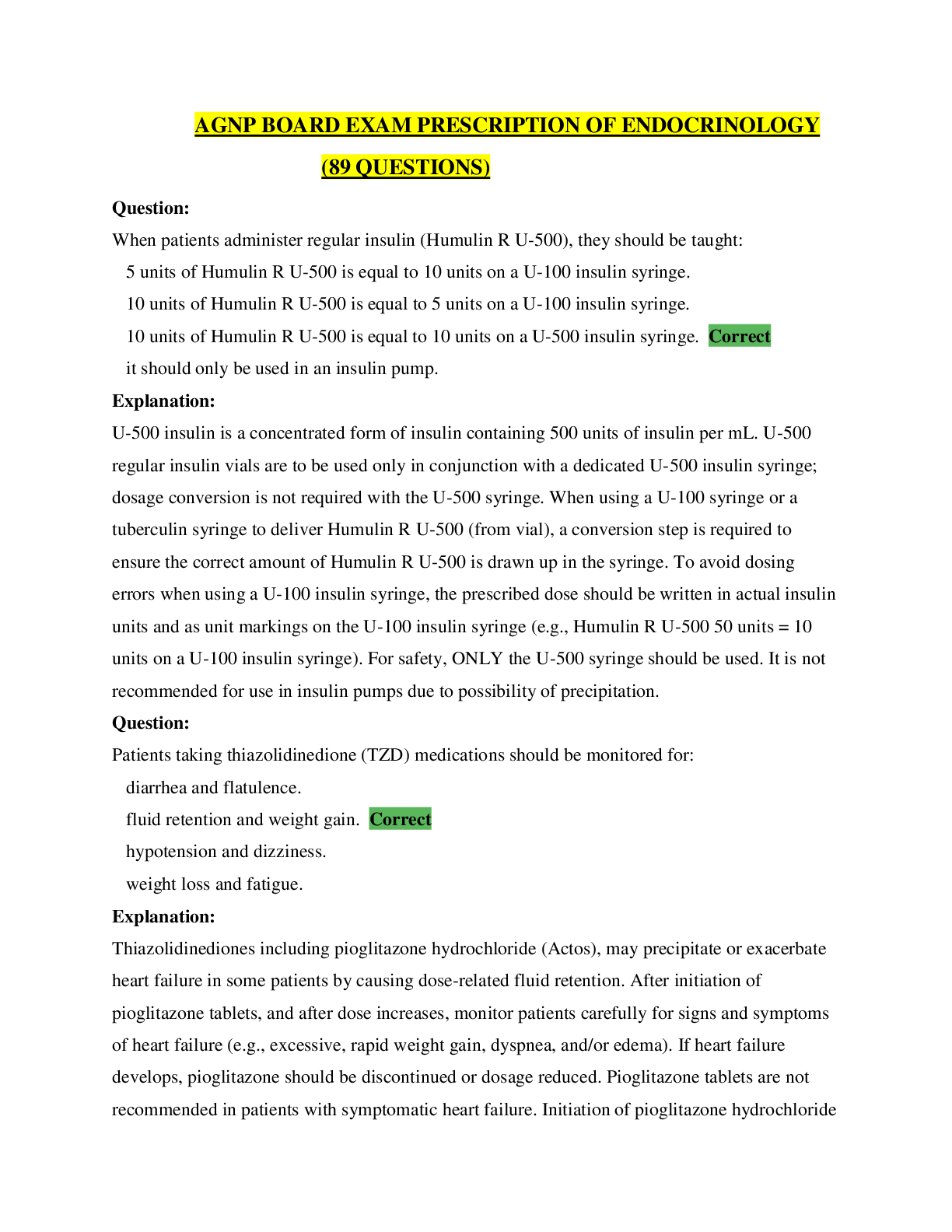
Buy this document to get the full access instantly
Instant Download Access after purchase
Add to cartInstant download
We Accept:

Reviews( 0 )
$12.00
Document information
Connected school, study & course
About the document
Uploaded On
Aug 07, 2021
Number of pages
38
Written in
Additional information
This document has been written for:
Uploaded
Aug 07, 2021
Downloads
0
Views
44



